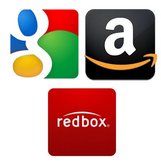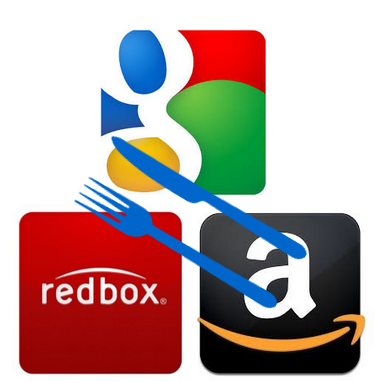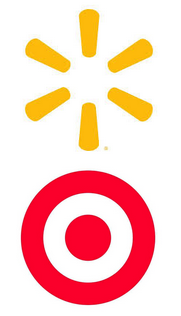How to Innovate Like Google, Redbox and Amazon

Remember the days when walking around Blockbuster was your Friday night?
Fast-forward a couple of years and Redbox is the movie provider I never knew I always wanted. If you walked up to the Mary of 2010 in Blockbuster I wouldn’t tell you that what I really want is a vending machine for movies- because I didn’t know.
Big brands know me better than I know myself.
It’s not by chance that Redbox knows me. And it’s not a coincidence that other similar companies like Google and Target are dominating their market.
Predicting user wants is one element of how companies like Google and Redbox succeed, but it is just one of many variables leveraged which consistently lead to success. Below are strategies leading companies use to become indispensable.

Malcolm Gladwell has a fantastic TED Talk which explains the advent of extra chunky tomato sauce and spicy pickles. Both of these products have only been around since the 1980’s but address unvoiced consumer wants that existed before those products. Similarly, Redbox was the movie service I wanted before I knew I wanted it, and Amazon’s mobile integration dominates my purchases.
“People don’t know what they want” – Malcolm Gladwell
Companies like Google and Amazon are constantly studying shopper behavior to understand what people want that they aren’t asking for, or don’t even know they want.
Recently Google updated Android with shopping notifications that alert mobile users near brick and mortar stores if those retailers carry products the mobile user had viewed online on on her phone. Similarly Amazon released #AmazonCart this month which lets Twitter users tweet items to their Amazon shopping cart.
Revolutionary companies:

Amazon famously started out as an online book seller. Today Amazon is a dominant retail search provider and is even taking some heat for ‘bullying’ publishers. Google started out as a free search engine, but generated $15.42 billion last quarter (Q1 2014) with a large portion of its revenue coming from paid ads, which saw a 26% increase from the previous year alone.
Big Companies like Google, Amazon, and Redbox are hungry.
If you follow news for Google, Amazon and similar companies you’ll notice they are constantly updating, adding services, acquiring. Big companies like Google are hungry for more of the market.
Amazon is a major online shopping provider. But Amazon also has its hands in cloud computing, e-readers, streaming shows, fulfillment, daily deals and is coming out with a smartphone this year.
Successful companies prioritize diversification.
Google is a search engine which arguably is evolving into a marketplace. Google has ventures in robotics, wearable technology, grocery delivery, mobile applications, social and so much more. Redbox recently started dabbling in streaming video, Target’s Red card is a strong sell for online shopping, and Verizon Wireless is attempting to make some headway in the cloud market.
One of the reasons Blockbuster didn’t rebound from Redbox is because they never innovated outside of their immediate product. Strong businesses are constantly looking to provide more services and products for their consumers.
Despite some pretty clever branding, Dollar Shave Club isn’t offering any new products. Men use razors, Dollar Shave club sells razors. Men can purchase similar razors at their local Target or Walgreens.
Innovative businesses turn something new into something you can’t live without.
What Dollar Shave Club does is create a need for men- in this case a need to not go to the store. Monthly subscription sites offer a new norm for online shoppers that reinvent how they shop by replacing shopping paradigms.
It’s no surprise that Google Glass was one of the first major wearable technologies. Google Glass may not be the future of wearable tech, but Google is at the forefront of the trend.
Businesses like Google create trends and leverage trends early on.
Facebook recently acquired Oculus to get in the wearables and gamification market. Amazon’s #Amazoncart is at the forefront of the merge for social and digital commerce. Google snapped up Youtube and Twitter is leveraging Vine with the popularity of video.

Google, Amazon and Target all resonate with users emotionally. Strong branding involves appealing to emotions, and standing behind a unified vision. Target is similar to Walmart in terms of inventory and overall function. But many people who shop at Target won’t step foot in Walmart. Target cultivates an environment and brand which endears itself to shoppers.
Branding plays a significant role in distinguishing businesses.
Similarly, Google has a strong connection with searchers, although it shares many of the same features as Bing or Duck Duck Go. Google features Google doodles, touts its unique company culture, and does an amazing job with marketing.
Before Google’s foray into social with Google+, Google unleashed the networking and messaging tool Google Buzz. Like Google+, Google Buzz enabled photo, video and messaging sharing but for Gmail users. Unlike Google+, which has had some recent troubles, Google Buzz was discontinued in December of 2011.
Google has discontinued at least two products or services every year since 2006.
Although Google+ involves different functionality than Google Buzz did (authorship, hangouts, more social, etc), Google released Google+ shortly after Google Buzz, in June of 2011. Google isn’t afraid to try new things, even when they are likely to fail.
Google answers 5 billion searches daily, and Redbox rents 1.2 million movies every day. You know what they say- shoot for the moon.
